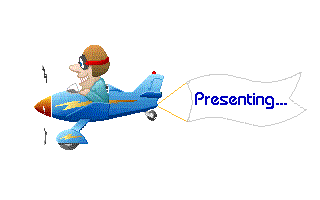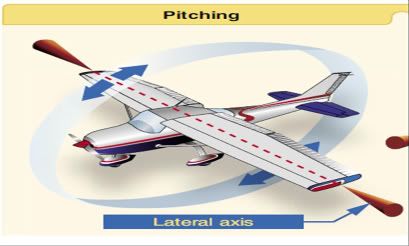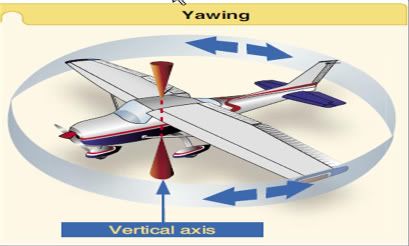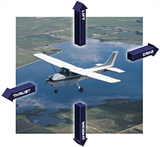As you may remember drag is one of the Four basic fundamentals of flight. But as the title suggests there are different types of drag. Not too get too detailed in this blog, there are at 2 main types of drag: parasite and induced drag.
Remember that drag is the force that resists movement of an airplane through the air. Parasite drag is so named because it in no way functions to aid in flight, while induced drag, is the result of an airfoil (wing) developing lift. Let's look at each a little closer.
PARASITE DRAG
Parasite drag is comprised of all the forces that work to slow the plane down, and as mentioned earlier does not play in the production of lift. There are 3 types of parasite drag: form drag, interference drag, and skin drag.
1. Form Drag
Form drag is the portion of parasite drag generated by the aircraft due to its shape and airflow around it. Examples, include engine cowlings, antennas, and aerodynamic shape of other components.
2. Interference Drag
Interference drag comes from the intersection of air streams that creates eddy currents, turbulence, or restricts smooth airflow. For example, the intersection of the wing and the fuselage at the wing root has significant interference drag. It is also highest when two surfaces meet at perpendicular angles.
3. Skin Friction Drag
Skin friction drag is the aerodynamic resistance due to the contact of moving air with the surface of the aircraft. No matter how apparently smooth a surface appears, has a rough, ragged surface when viewed under a microscope. The actual speed at which the air molecules move depends upon the shape of the wing, the stickiness of the air through which the wing or airfoil is moving, and the compressibility.
INDUCED DRAG
In level flight the aerodynamic properties of a wing or rotor produce a required lift, but at the expense of a certain penalty. Induced drag is the name of the penalty. Induced drag is inherent whenever an airfoil is producing lift, and this type of drag is inseparable from the production of lift. It is always present of lift is produced.
Whenever an airfoil is producing lift, the pressure on the lower surface of it is greater than that on the upper surface (Bernoulli's Principle).
In the area of the wing tips, there is a tendency for these presures to equalize, resulting in a lateral flow outward from the underside to the upper surface. When viewed from the tail, vortices from the wing tips trail behind the airfoils. This also creates a downwash flow behind the wing's trailing edge. In simple terms, this downwash flow, in a sense, is the induced drag that is created when the plane has produced lift.

Wednesday, February 20, 2013
Saturday, February 16, 2013
3 Axis of Rotation
The axis of an aircraft are three imaginary lines that pass through an aircraft's CG (center of gravity). These axis can be thought of as imaginary axles around which the aircraft turns. They pass through the CG at 90 degree angles to each other.
These three are called the lateral, longitudinal, and vertical axis.
LATERAL AXIS
The axis that passes from wingtip to wingtip is known as the lateral axis. When the plane rotates on this axis, it is pitching up and down. Lateral axis creates a PITCH.

LONGITUDINAL AXIS
The axis that passes from nose to tail is known as the longitudinal axis. In this action the plane does a rolling motion, which is a major component in a turn. Longitudinal axis creates a ROLL.

VERTICAL AXIS
The axis that passes vertically through the CG is the vertical axis. This action causes the plane to yaw, turn left or right without the benifit of "tilting" the plane. Vertical axis creates a YAW.

These names have been adapted to aeronautical terminolgy due to the similarity of aircraft and seagoing ships.
These three actions of the conventional airplane, (pitch, roll, or yaw) are control by three control surfaces. Pitch is controlled by the elevators; roll is controlled by the ailerons; yaw is controlled by the rudder. (more on these surfaces in future lessons). Whenever an aircraft changes its flight attitude or position in flight, it rotates about one or more of these three axis.
These three are called the lateral, longitudinal, and vertical axis.
LATERAL AXIS
The axis that passes from wingtip to wingtip is known as the lateral axis. When the plane rotates on this axis, it is pitching up and down. Lateral axis creates a PITCH.

LONGITUDINAL AXIS
The axis that passes from nose to tail is known as the longitudinal axis. In this action the plane does a rolling motion, which is a major component in a turn. Longitudinal axis creates a ROLL.

VERTICAL AXIS
The axis that passes vertically through the CG is the vertical axis. This action causes the plane to yaw, turn left or right without the benifit of "tilting" the plane. Vertical axis creates a YAW.

These names have been adapted to aeronautical terminolgy due to the similarity of aircraft and seagoing ships.
These three actions of the conventional airplane, (pitch, roll, or yaw) are control by three control surfaces. Pitch is controlled by the elevators; roll is controlled by the ailerons; yaw is controlled by the rudder. (more on these surfaces in future lessons). Whenever an aircraft changes its flight attitude or position in flight, it rotates about one or more of these three axis.
Sunday, February 10, 2013
Four Basic Fundamentals of Flight
 There are 4 fundamentals of flight that are imposed on every plane in flight. These four forces acting on an aircraft in straight-and-level, unaccelerated flight are thrust, drag, lift and weight. I will talk about each and explain how these act on the plane. They are defined as follows:
There are 4 fundamentals of flight that are imposed on every plane in flight. These four forces acting on an aircraft in straight-and-level, unaccelerated flight are thrust, drag, lift and weight. I will talk about each and explain how these act on the plane. They are defined as follows:THRUST
Thrust is that force that causes a plane to move forward. It is produced by the power plant/propeller or rotor. It opposes, overcomes, and is opposite of drag. As a general rule, it acts parallel to the longitudinal axis. (More on axis in the next blog).
DRAG
Drag is the rearward, retarding force caused by the disruption of airflow over the wing, rotor, fuselage, and other objects that protrude from the plane. As mentioned earlier, drag and thrust are opposites, and acts rearward parallel to the relative wind.
LIFT
Lift opposes the downward force of weight, is produced by the effect of the air acting on the wings, and acts perpendicular to the flight path.
WEIGHT
Weight is the combined load of the aircraft itself, the crew, the fuel, and cargo. Weight pulls the plane downward because of the force of gravity. It acts opposite of lift, and acts vertically downward through the CG (center of gravity).

In steady flight the sum of all forces is always zero. It does not mean that the four forces are equal. It means the opposing forces are equal to each other and therefore cancel each other out. See figure above.
So in steady, level, flight the sum of all upward forces (lift) equals the sum of all downward forces (weight).
And the sum of all forward forces (thrust) equals the sum of all backward forces (drag).
For an aircraft to move forward thrust must be greater than drag. As the plane continues to move forward and gains speed, then at some point thrust and drag will be equal. Which means that to maintain constant airspeed, thrust and drag are equal. For a constant altitude, lift and weight must be equal.
If thrust is less than drag the plane will slow down, but once thrust is greater than drag , the plane speeds up.
Subscribe to:
Posts (Atom)
